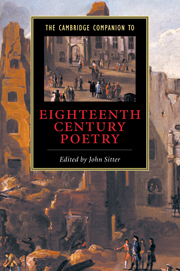Book contents
- Frontmatter
- 1 Introduction
- 2 Couplets and conversation
- 3 Political passions
- 4 Publishing and reading poetry
- 5 The city in eighteenth-century poetry
- 6 “Nature” poetry
- 7 Questions in poetics
- 8 Eighteenth-century women poets and readers
- 9 Creating a national poetry
- 10 The return to the ode
- 11 A poetry of absence
- 12 The poetry of sensibility
- 13 “Pre-Romanticism” and the ends of eighteenth-century poetry
- Index
8 - Eighteenth-century women poets and readers
Published online by Cambridge University Press: 28 May 2006
- Frontmatter
- 1 Introduction
- 2 Couplets and conversation
- 3 Political passions
- 4 Publishing and reading poetry
- 5 The city in eighteenth-century poetry
- 6 “Nature” poetry
- 7 Questions in poetics
- 8 Eighteenth-century women poets and readers
- 9 Creating a national poetry
- 10 The return to the ode
- 11 A poetry of absence
- 12 The poetry of sensibility
- 13 “Pre-Romanticism” and the ends of eighteenth-century poetry
- Index
Summary
During the eighteenth century, British women poets built upon and varied the repertory of styles and topics bequeathed them by their foremothers. They also entered the literary marketplace in ever-greater numbers. The rising number of women poets may seem to have been predictable, given the increased access to print by writers of both sexes after the seventeenth-century lapse of laws circumscribing the press. Professional male writers were soon so numerous that the hack, that ubiquitous feature of late-seventeenth- and eighteenth-century satire, was an established cultural icon. In fact, however, numerous factors challenged aspiring women poets. Chief, perhaps, was the conservative ideology governing notions of femininity, a trend that became ever more restrictive throughout the century. Women of middling and upper status were encouraged to define themselves as mothers and household managers rather than as active contributors to their family economies. These roles sanctioned women's pursuit of domestic activities such as childhood education but inhibited their participation in such public business as politics and scholarship. The marketing of one's literary productions was another process that involved some transactions within the public domain. If all women writers had heeded the advice that conduct books so assiduously inculcated throughout the century, few would have ventured beyond the occasional birthday tribute enclosed in a letter, or the funeral elegy confided to a journal.
- Type
- Chapter
- Information
- The Cambridge Companion to Eighteenth-Century Poetry , pp. 157 - 176Publisher: Cambridge University PressPrint publication year: 2001
- 3
- Cited by

